Machine learning (ML) is no longer just a concept for forward-looking tech teams—it’s quickly becoming a cornerstone of innovation for businesses across industries. Yet, for many teams, knowing where to begin with ML software can feel overwhelming. The good news? Open-source tools offer an accessible starting point, empowering users to build models, analyze data, and unlock insights without the high costs of proprietary solutions.
Python, one of the most popular languages for ML, stands out for its simplicity and adaptability across diverse use cases. Its robust open-source ecosystem has developed useful libraries like TensorFlow and scikit-learn, making it easier than ever to design and deploy ML models.
Whether your team is exploring ML for the first time or looking to refine your approach, the right open-source tools—paired with Python—can deliver real value and set the stage for long-term success. Let’s take a closer look at some of the best tools available and how they can elevate your ML capabilities.
What is Machine Learning?
Machine learning is a subfield of artificial intelligence (AI) that allows computers and machines to learn from data without explicit programming. ML systems automatically improve their performance through experience by identifying patterns in the provided data.
Supervised learning
Supervised learning is one of the most common types of ML. With supervised learning, the algorithm learns from labeled data to make better predictions or decisions with new data. The goal is to find a function that maps inputs to outputs with as little error as possible. Some examples of supervised learning include image classification and speech recognition.
Unsupervised learning
Unsupervised learning involves finding hidden patterns in unlabeled data. The algorithm attempts to identify similarities and differences among the input features without any prior knowledge of what they represent. Clustering algorithms are an example of unsupervised learning because they group similar items based on their attributes.
Reinforcement learning
Reinforcement learning entails an agent interacting with its environment through trial-and-error experiences to maximize a reward signal over time. This approach allows the agent to learn which actions yield the best outcomes in specific scenarios. Reinforcement learning is often applied in gaming—think online chess or games where AI plays against humans by making moves and considering future possibilities within reasonable timeframes. As the AI continues to play, it refines its strategies, learning from each interaction to make better decisions and improve performance over time.
Benefits of Open-Source Tools
Open-source software (OSS) has revolutionized machine learning by providing accessible and flexible tools for researchers, developers, and businesses alike. Key benefits include:
- Affordability: Open-source tools are generally free to use, which significantly lowers the barrier to entry for individuals, startups, and small businesses. Even larger enterprises benefit by cutting down on software licensing costs. This cost-effectiveness allows organizations to allocate resources toward other critical areas, such as data acquisition or model deployment.
- Greater flexibility: Open-source tools offer unparalleled adaptability. Developers can modify source code to fit specific project needs, creating tailored solutions that proprietary software often cannot provide. This flexibility is particularly important in machine learning projects, where unique datasets or experimental models may require custom functionalities. Additionally, open-source tools often integrate seamlessly with other libraries, enabling a modular approach to building machine learning pipelines.
- Avoid vendor lock-in: Proprietary solutions often tie users to a specific vendor’s ecosystem, making it challenging to migrate projects or adapt to evolving technology needs. Open-source tools, however, provide full transparency and control over the software. Users retain ownership of their data and workflows, enabling smoother transitions across platforms or cloud providers. This freedom fosters innovation and ensures that organizations remain agile in responding to changing business requirements or industry trends.
- Collaborative nature: Open-source tools are built and maintained by global communities of contributors, including developers, researchers, and industry professionals. This collaborative environment ensures that these tools are continuously updated with new features, performance improvements, and bug fixes. The community aspect also facilitates knowledge sharing through forums, tutorials, and case studies, enabling users to learn from others’ experiences and contribute their own insights.
8 Best Machine Learning Software Tools to Use
OSS has played a significant role in the development of ML models, as it helps organizations build robust AI systems without demanding significant resources for proprietary software licenses.
There’s an abundance of options tailored to different needs, from building models to managing complex workflows. Here’s a look at some of the most impactful ones and what makes them essential for professionals in the field:
1. Anaconda
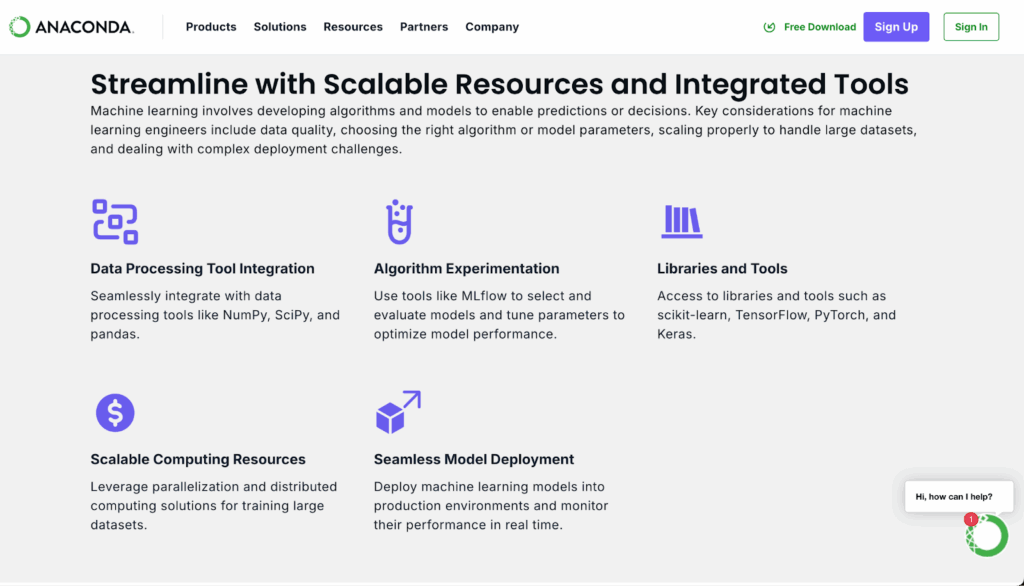
Anaconda is a leading open-source platform for AI and machine learning optimized for large-scale data processing, predictive analysis, and scientific computing. It simplifies package management and environment setup, making it indispensable for data scientists and AI/ML professionals.
Key features include pre-installed libraries like NumPy, pandas, and Matplotlib, which allow users to start projects immediately and securely. Anaconda also enables creating and managing virtual environments, ensuring project dependencies remain isolated. Its cross-platform support makes it easy to work seamlessly across Windows, macOS, and Linux.
Anaconda is ideal for managing machine learning workflows, handling complex dependencies, and simplifying environment setup for diverse projects.
2. Python
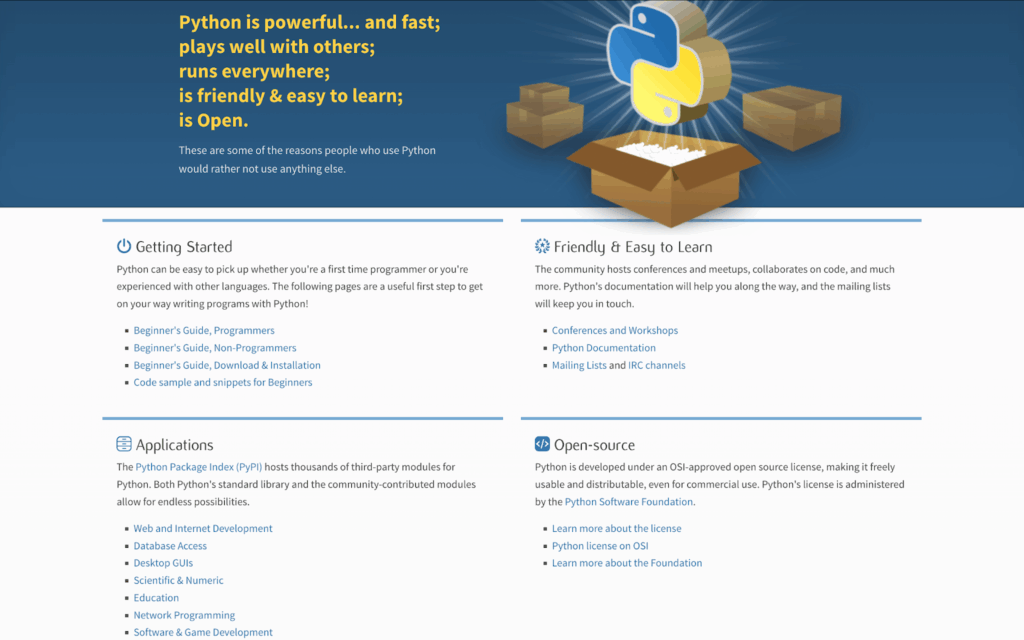
As the backbone of most machine learning frameworks, Python stands out for its simplicity and versatility. With a beginner-friendly syntax and readable code structure, it allows both novices and experts to grasp and implement complex concepts.
Python’s extensive library ecosystem makes it powerful for building machine learning models and algorithms. The vast Python community also ensures that users have access to a wealth of resources, including documentation, tutorials, and forums, which accelerates learning and development.
Whether it’s prototyping algorithms, integrating machine learning solutions, or creating end-to-end models, Python remains the go-to language for machine learning development, data science, and AI as a whole.
3. TensorFlow
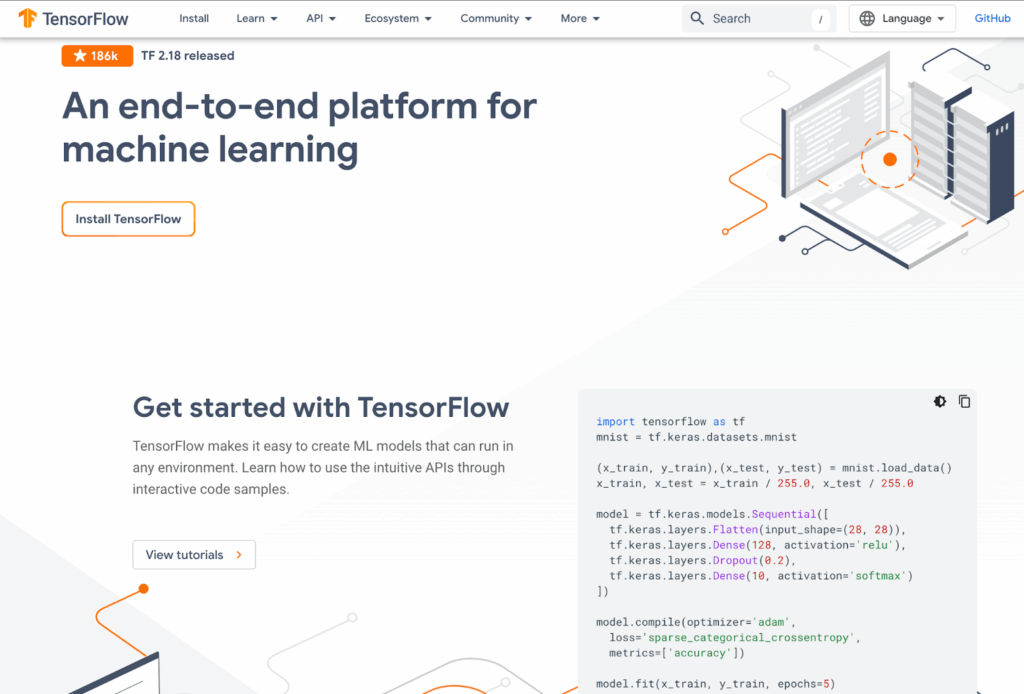
TensorFlow is a popular open-source, community-maintained library first developed by Google for creating and training machine learning models. It leverages GPUs for accelerated computation and supports neural networks like CNNs, RNNs, and DNNs, offering flexibility for various AI challenges.
Key features include tools for designing, training, and deploying models, as well as integration with other Python libraries. A strong community provides extensive resources, tutorials, and forums.
TensorFlow is widely used for tasks ranging from local development to deploying scalable solutions on cloud infrastructures.
4. PyTorch
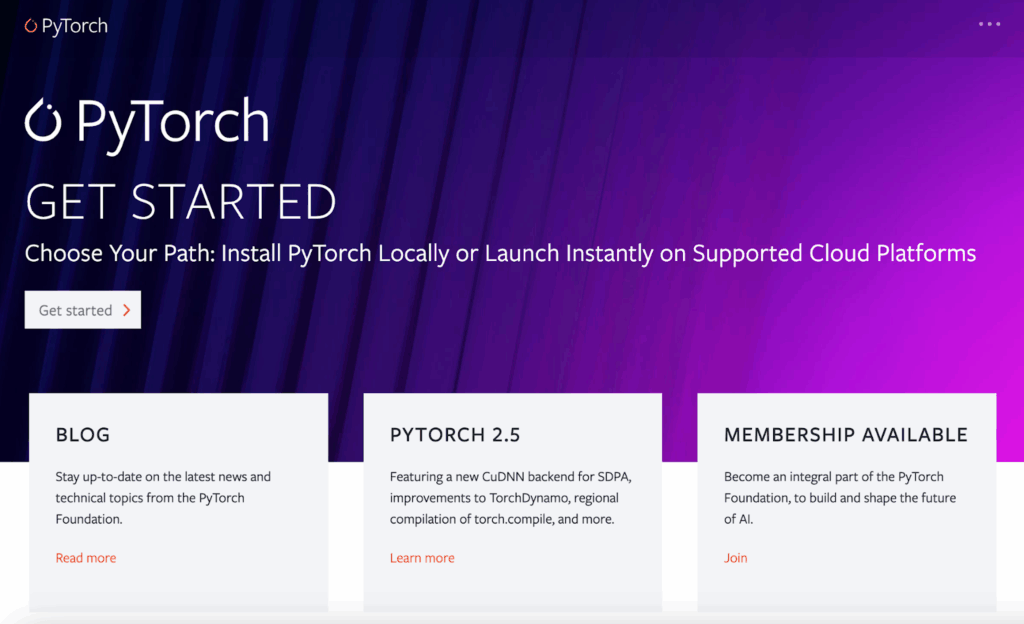
PyTorch is an open-source deep learning library that offers a flexible framework for building neural networks. It is especially useful for natural language processing and computer vision projects requiring custom model architectures.
Its features include Pythonic model-building capabilities, efficient optimization during training, and supplementary tools like PyTorch Lightning and Torchvision for simplifying workflows.
PyTorch is often chosen for research-oriented projects and applications requiring tailored deep learning models.
5. scikit-learn
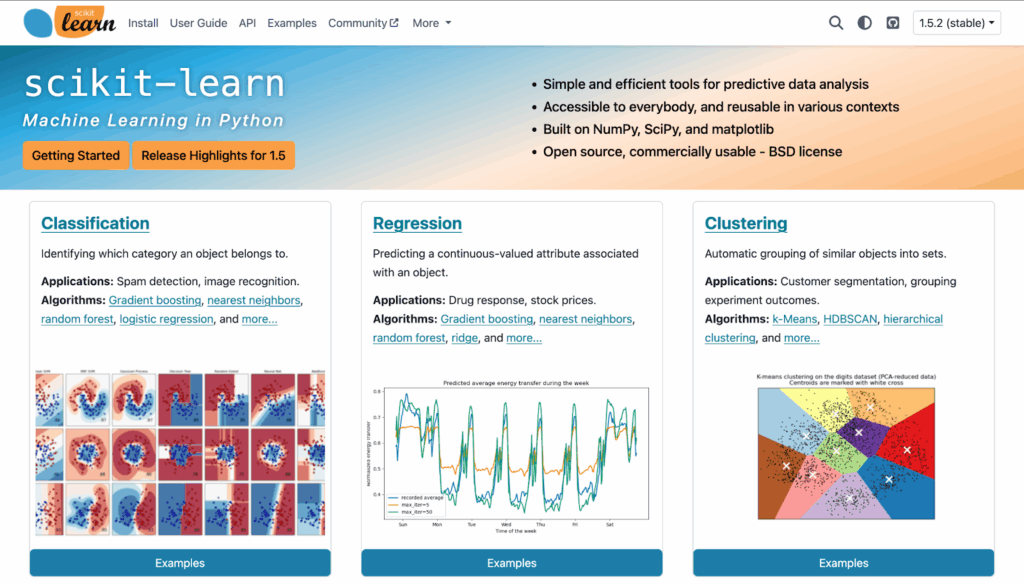
Scikit-learn is a Python library designed for machine learning, offering tools for data preprocessing, model training, and evaluation. It excels in feature engineering, such as managing missing values and transforming datasets.
Scikit-learn offers integration with libraries like NumPy and pandas streamlines workflows, while built-in cross-validation ensures robust model evaluation.
Scikit-learn is ideal for building and testing machine learning models, especially for projects requiring extensive preprocessing and evaluation.
6. Jupyter Notebook
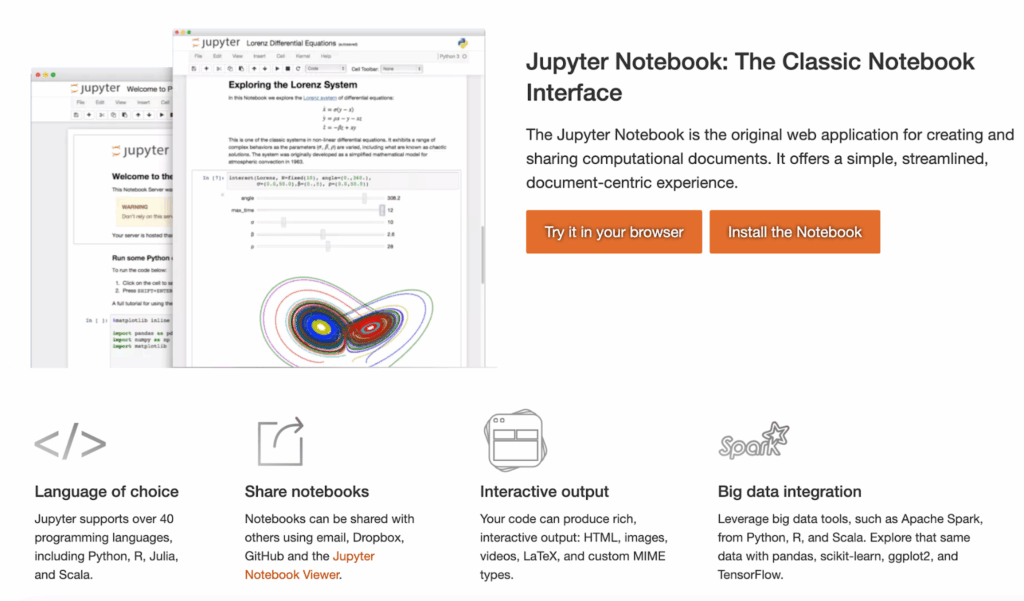
Jupyter Notebook is an open-source web application for interactive coding, data visualization, and documentation. It supports multiple languages, with Python being the most popular, and allows users to execute code in real time.
Its Markdown capabilities make it easy to mix code, text, and visuals, fostering collaboration and knowledge sharing. It integrates seamlessly with Anaconda for a smooth workflow.
Jupyter Notebook is widely used for prototyping, data analysis, and creating shareable reports.
7. R
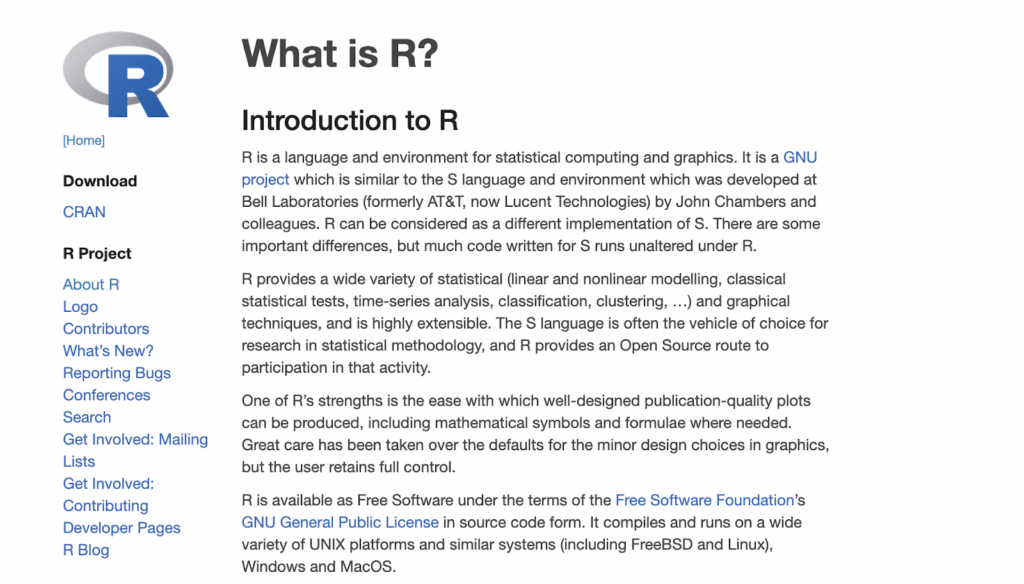
R is a programming language tailored for statistical analysis and machine learning, featuring libraries like ggplot2 for visualization and tools for handling complex models. The caret, mlr3, and h2o packages are essential for machine learning in R.
It is particularly strong in exploratory data analysis, making it a go-to choice for fields like bioinformatics and economics.
R is best suited for data-intensive projects that demand advanced statistical insights and robust visualizations.
8. Keras
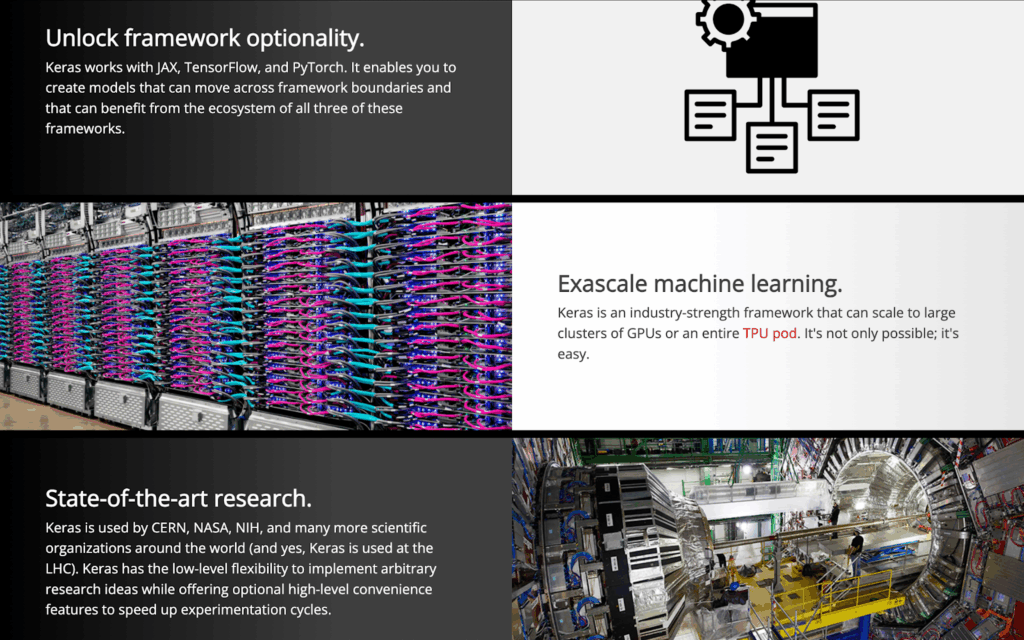
Keras is a high-level Python library for building neural networks, enabling fast experimentation with convolutional and recurrent models.
Key features include support for multi-input/output models, compatibility with backends like TensorFlow, PyTorch, and JAX, and flexibility for tasks like text classification and language generation.
Keras is best for quickly prototyping and experimenting with neural network architectures.
Top Resources for Getting Started with Machine Learning Software
Getting familiar with machine learning software can seem daunting, but there are many resources that can help you get started and progress in your journey. Whether you prefer structured courses, reading blogs, or watching video tutorials, there’s something for everyone.
1. Learning Platforms
For those looking to get hands-on with machine learning tools like Anaconda, platforms that offer structured, interactive learning experiences are invaluable. Anaconda Learning is a fantastic starting point, especially for those planning to leverage Anaconda Navigator or Jupyter Notebooks for their projects. Anaconda’s learning materials cover the essentials of machine learning algorithms and data science, offering tutorials on how to manage environments, work with libraries like PyTorch and scikit-learn, and integrate various data science tools effectively.
2. Online Blogs
There are countless blogs offering insights into machine learning, ranging from theoretical concepts to practical tutorials on using specific tools and libraries.
- Medium hosts many contributors who cover a wide array of topics related to machine learning, from beginner introductions to advanced applications. For instance:
- Blogs from Kaggle and Towards Data Science are especially valuable for staying up-to-date with industry trends, as well as finding step-by-step tutorials and use case examples.
- Google AI Blog and OpenAI Blog are great resources for learning about cutting-edge research and applications in the field.
- Additionally, blogs from Microsoft, AWS, and IBM offer deep dives into how their machine learning products and services can be leveraged for real-world problems.
3. Videos
For more visual and interactive learners, video content is a great way to grasp machine learning concepts and see software in action.
- Platforms like YouTube have an abundance of content focused on machine learning, offering tutorials that break down complex algorithms and concepts into digestible chunks.
- On TikTok, there are shorter, quick tips and hacks from machine learning enthusiasts, making it a great option for bite-sized learning or getting inspiration.
- Instagram also hosts numerous data science professionals who share tips, quick tutorials, and inspiration for budding machine learning engineers.
So Many Choices — and Anaconda Can Help
Machine learning software empowers users to analyze data, identify patterns, and make predictions, enabling advancements in fields like healthcare, finance, marketing, and technology. From training predictive models to building recommendation systems or automating processes, these tools are the backbone of modern AI-driven solutions.
Anaconda simplifies access to open-source ML tools in the cloud, offering a one-stop platform with no-cost options. Create your free account and get started with Anaconda today.
Working for a business that is using OSS for enterprise use cases? Schedule a demo and we’ll show you how to streamline access to open-source Python tools across your organization.
About Anaconda
With more than 35 million users, Anaconda is the world’s most popular platform to develop and deploy secure Python solutions, faster. We pioneered the use of Python for data science, champion its vibrant community, and steward the open-source projects behind tomorrow’s artificial intelligence (AI) and machine learning (ML) breakthroughs. Our solutions enable practitioners and institutions around the world to securely harness the power of open source for competitive advantage and groundbreaking discoveries.